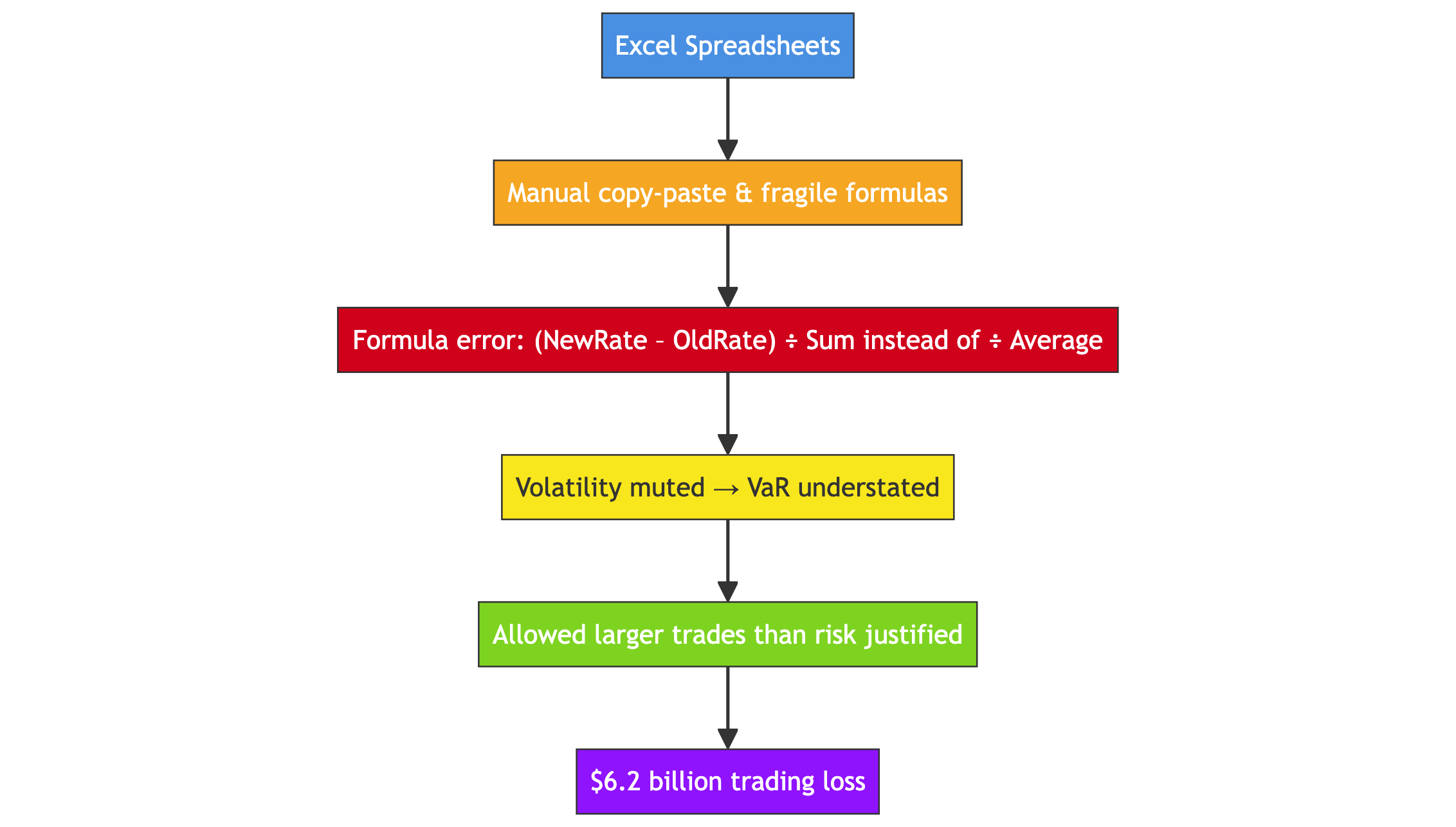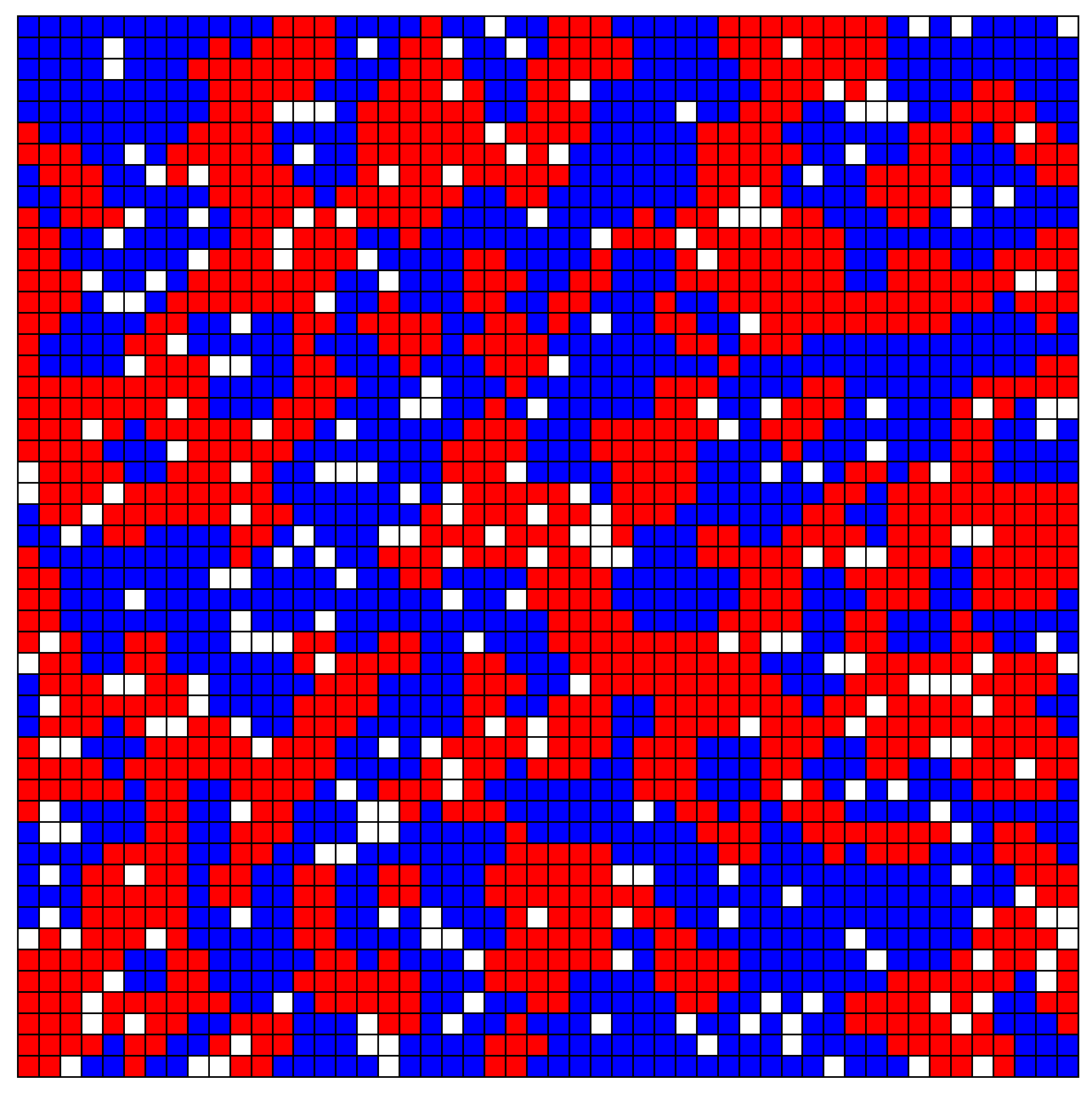🗓️ Week 03
Computational Thinking and Programming
DS101 – Fundamentals of Data Science
13 Oct 2025
Excel…
Mentimeter: What do you think of Excel?
Mentimeter: Excel mishaps
The Excel Problem
Excel is great for:
- Quick data entry
- Simple calculations
- Basic visualization
- Non-technical users
But dangerous for:
- Data science workflows
- Reproducible analysis
- Large datasets
- Collaborative projects
Let’s see why with some real examples…
Horror Story #1: Gene Names

Source: (Vincent 2020)
What happened:
- Excel auto-converted gene names to dates
- MARCH1 (short for “Membrane Associated Ring-CH-Type Finger 1”) → 1-Mar
- SEPT2 (short for “Septin 2”)→ 2-Sep
The scale:
- 2016 study (Ziemann, Eren, and El-Osta 2016): ~20% of 3,597 genomics papers affected by Excel gene name conversion
- 2021 follow-up (Abeysooriya et al. 2021): Still 30.9% of 11,117 papers had errors
- Problem persisted despite awareness!
The fix: 27 genes officially renamed (MARCH1 → MARCHF1)
Horror Story #2: COVID-19 Data Loss

Source: (Hern 2020)
The incident:
- UK Public Health England used Excel as exchange format with local trusts
- Hit the 65,536 row limit
- Lost 16,000 COVID cases
- Delayed contact tracing
Impact: Lives at risk
Horror Story #3: Economic Policy

Source: (“The Excel Depression” 2013)
Reinhart-Rogoff spreadsheet error:
- Influential economics paper
- Original results showed average real economic growth slows (a 0.1% decline) when a country’s debt rises to more than 90% of gross domestic product
- Influenced austerity policies globally
- But, Excel formula excluded 5 rows (i.e 5 countries: Australia, Austria, Belgium, Canada and Denmark)
- Wrong conclusions about debt/GDP (when that error was corrected, the “0.1% decline” data became a 2.2% average increase in economic growth)
Lesson: Always check your formulas!
Horror Story #4: The London Whale

Source: (Kwak 2013)
Horror Story #4: The London Whale

JP Morgan VaR Model (2012)
- Built entirely in Excel
- Manual copy-paste & fragile formulas
- Formula error: divided by sum instead of average → VaR understated
- Model review flagged issues but flaws never fixed
- Resulted in $6.2 billion trading loss
Lesson:
Even sophisticated financial models fail on fragile, manually managed software. Critical calculations need robust, auditable systems.
Horror Story #5: Microsoft and Finance

Source: (Beales 2013)
A pattern of Excel-related failures:
2007 CPDOs (i.e Constant proportion debt obligations): Moody’s coding error inflated structured finance ratings (pre-crisis)
2012 London Whale: JPMorgan’s Excel-based risk model failures ($6.2B loss)
2013 Reinhart-Rogoff: Spreadsheet error undermined influential austerity research
The pattern: Office tools used as substitutes for proper systems and critical thinking
The Excel Takeaway

Excel is NOT for:
- Serious data science
- Reproducible analysis
- Large-scale data processing
- Production systems
Excel IS fine for:
- Quick data exploration
- Small personal datasets
- Initial data entry
- Simple calculations
Just know its limitations!
Excel wrap-up Mentimeter 💭
What do these stories have in common?
- Human error 🧍♀️
- Hidden assumptions
- Manual, fragile processes
- Tools used beyond their limits
“Excel doesn’t make mistakes. People do.”
It’s not about Excel…
These stories aren’t really about spreadsheets.
They’re about thinking — or rather, the lack of computational thinking.
From Chaos to Clarity
| Spreadsheet World | Computational Thinking |
|---|---|
| 🧍♀️ Manual formulas | 🤖 Explicit procedures |
| ❌ Hidden logic | ✅ Transparent logic |
| 😬 Fragile systems | 💪 Reproducible steps |
| 🌀 Chaos | 🧩 Clarity |
Computational Thinking
Mentimeter quiz
What is computational thinking? 🧠
A mindset for solving problems so precisely that a computer could follow your logic — even if it’s terrible coffee-fuelled logic ☕💻
More formally, it involves:
1️⃣ Designing computations that get computers to do jobs for us
2️⃣ Explaining and interpreting the world as a complex information process
Two Aspects of Computational Thinking
1️⃣ Designing computations (thinking like a computer)
- Input: numbers, symbols, lists
- Output: a solution
- Computation: deterministic calculations & symbolic manipulation
- Example: sorting a list, calculating shortest paths
2️⃣ Explaining and interpreting the world (modeling complexity)
- Example: Schelling’s segregation model 🏘️ (McCown 2014)

💬 Discussion Prompt:
- “What patterns do you think emerge if residents move when unhappy?”
Schelling Model – How it works
Input: grid of neighbouring households (two colors to distinguish type), tolerance threshold (e.g 30% of neighbours of different type)
Output: reordered grid
- Each resident checks neighbors
- If below tolerance threshold → move to nearest empty spot that satisfies preference
- Repeat until all residents are “happy”
💬 Observation:
- Mild individual preferences → strong segregation patterns
- No one intended overall segregation → emergent behavior
Schelling Model – Computational Thinking Takeaway
- Computers allow many iterations quickly
- Helps explain real-world social patterns
- This is an algorithm: rules → step-by-step, deterministic computation
“Next, we’ll focus on designing precise rules — algorithms — to solve tasks.”
Try It Yourself: Making Tea ☕
Imagine a robot has never seen tea.
Task: Write the first three instructions to make a cup of tea.
💬 Discuss at your table: what’s tricky about giving precise instructions?
Tea Algorithm ☕
One possible precise algorithm:
- Fill kettle
- Boil water
- Put tea bag in cup
- Pour water
- Wait 3 minutes
- Remove tea bag
- Enjoy ☕
💬 Step-by-step, unambiguous, finite, feasible — now let’s formalize algorithm properties.
What is an algorithm? 📊
Definition:
- A recipe for solving a problem in a finite, step-by-step, unambiguous way

Properties:

Sorting…
Input:
[10, 20, 42, 29, 50]
Output:
[10, 20, 29, 42, 50]
Computation:
How would you solve it❓
🎯 Action Point
Group up with the people of your respective tables and try to come up with a recipe that solves the problem, regardless of the list size.
Test that your recipe works for the following list:
[237, 153, 311, 33, 854, 212, 368, 42, 892, 755]Time for a break 🍵

After the break:
- Other algorithm examples
Time to look at another example of algorithm
Scenario: Campus walk from Marshall Building to other locations
Graph (distances in meters):

Discovery:
- Could you try and find the shortest path from Marshall → all other nodes?
Dijkstra’s Algorithm – Step by Step Solution
Step 0 – Initialization:
- MAR=0, others=∞
- Previous = undefined
- Unvisited={MAR,FAW,COL,SSC,LRB}
| MAR | FAW | COL | SSC | LRB | |
|---|---|---|---|---|---|
| Distance | 0 | \(\infty\) | \(\infty\) | \(\infty\) | \(\infty\) |
Dijkstra’s Algorithm – Step by Step Solution
Step 1 – Current node = MAR
- Update neighbors:
- FAW: 0+200=200 → FAW=200, prev=MAR
- COL: 0+300=300 → COL=300, prev=MAR
- SSC: 0+350=350 → SSC=350, prev=MAR
- LRB: 0+400=400 → LRB=400, prev=MAR
- Mark MAR visited
| MAR | FAW | COL | SSC | LRB | |
|---|---|---|---|---|---|
| Distance | 0 | 200 | 300 | 350 | 400 |
Dijkstra’s Algorithm – Step by Step Solution
Step 2 – Current node = FAW (200)
- Neighbors: COL, SSC
- COL: via FAW 200+150=350 > 300 → no update
- SSC: via FAW 200+180=380 > 350 → no update
- Mark FAW visited
| MAR | FAW | COL | SSC | LRB | |
|---|---|---|---|---|---|
| Distance | 0 | 200 | 300 | 350 | 400 |
Dijkstra’s Algorithm – Step by Step Solution
Step 3 – Current node = COL (300)
- Neighbor: SSC
- SSC: via COL 300+100=400 > 350 → no update
- Mark COL visited
| MAR | FAW | COL | SSC | LRB | |
|---|---|---|---|---|---|
| Distance | 0 | 200 | 300 | 350 | 400 |
Dijkstra’s Algorithm – Step by Step Solution
Step 4 – Current node = SSC (350)
- Neighbor: LRB
- LRB: via SSC 350+120=470 > 400 → no update
- Mark SSC visited
| MAR | FAW | COL | SSC | LRB | |
|---|---|---|---|---|---|
| Distance | 0 | 200 | 300 | 350 | 400 |
Dijkstra’s Algorithm – Step by Step Solution
Step 5 – Current node = LRB (400)
- Neighbors: none unvisited
- Mark LRB visited → Done
| MAR | FAW | COL | SSC | LRB | |
|---|---|---|---|---|---|
| Distance | 0 | 200 | 300 | 350 | 400 |
Dijkstra’s Algorithm – Step by Step Solution
Final shortest distances & paths:
| Node | Distance | Path |
|---|---|---|
| MAR | 0 | MAR |
| FAW | 200 | MAR → FAW |
| COL | 300 | MAR → COL |
| SSC | 350 | MAR → SSC |
| LRB | 400 | MAR → LRB |
Dijkstra’s algorithm in words
Step 1: Mark the source node with a current distance of 0 and the rest with infinity
Step 2: Set the non-visited node with the smallest current distance, as the current node, let’s say
c(initiallycis set to the source node).Step 3: For each neighbour
Nof the current nodec: add the current distance ofcwith the weight of the edgec-N. If it is smaller than the current distance ofN, set it as the new current distance ofN.Step 4: Mark
cas visited.Step 5: Go to Step 2 if there are any unvisited nodes.
Use cases for shortest path algorithms (and Dijkstra algorithm)
- find optimal directions between locations (e.g Google Maps-see here for a further explanation)/GPS Navigation: considering real-traffic conditions, calculate the shortest path between a source and destination in navigation systems
- determine the shortest path between network nodes, helping in efficiently routing data packets (used in computer networks but also telephone networks)
- recommendation systems: find the most relevant and shortest path between items or users (e.g movie recommendations, recommendations of items to buy)
- social networks: suggest a list of friends that a user may know
Time for some voting! 🗳️
Scenario: Let’s votes for favorite café/tea shop!
- Voters: Vansh, Unai, Manuela, Ria, Luka, Ziad, Zayd
- Options: Pürcha, Garrick, Blank Street Café
Here are the voters’ preferences?
Preferences:
| Student | Rank 1 | Rank 2 | Rank 3 |
|---|---|---|---|
| Vansh | Pürcha | Garrick | Blank Street Café |
| Unai | Blank Street Café | Pürcha | Garrick |
| Manuela | Garrick | Pürcha | Blank Street Café |
| Ria | Garrick | Blank Street Café | Pürcha |
| Luka | Pürcha | Garrick | Blank Street Café |
Discovery: How would you go about the vote?
Voting: a breakdown
Majority Vote
Count first-place votes:
- Pürcha: Vansh + Luka = 2
- Garrick: Manuela + Ria = 2
- Blank Street Café: Unai = 1
No majority (>50%) → need tie-break rules or runoff
Observation: Borda count can break ties where majority fails
Borda Count
Assign points to each rank: 1st place = 3 pts, 2nd = 2 pts, 3rd = 1 pt
Sum points:
- Pürcha: Vansh 3 + Unai 1 + Manuela 2 + Ria 1 + Luka 3 = 10
- Garrick: Vansh 2 + Unai 1 + Manuela 3 + Ria 3 + Luka 2 = 11
- Blank Street Café: Vansh 1 + Unai 3 + Manuela 1 + Ria 2 + Luka 1 = 8
✅ Winner (Borda): Garrick (11 pts)
Voting algorithms in words
Borda count
- Assign points to ranks
- Sum points per option
- Option with highest total wins
Majority voting
- Count first-choice votes
- Option with >50% wins
- If none, apply tie-break/runoff
Time for assigning tasks!
Suppose you had the following scenario:
Students: Vansh, Unai, Manuela Tasks: Prepare slides, Book meeting room room, Bring snacks
Original costs (time in minutes):
| Slides | Room | Snacks | |
|---|---|---|---|
| Vansh | 10 | 15 | 9 |
| Unai | 9 | 18 | 5 |
| Manuela | 6 | 14 | 3 |
How would you go about assigning the tasks?
How does the Hungarian algorithm work?
Step 1 — Subtract the minimum from every element of each row
| Slides | Room | Snacks | |
|---|---|---|---|
| Vansh | 10 | 15 | 9 |
| Unai | 9 | 18 | 5 |
| Manuela | 6 | 14 | 3 |
\(->\)
| Slides | Room | Snacks | |
|---|---|---|---|
| Vansh | 1 | 6 | 0 |
| Unai | 4 | 13 | 0 |
| Manuela | 3 | 11 | 0 |
How does the Hungarian algorithm work?
Step 2 — Subtract the minimum of each column
| Slides | Room | Snacks | |
|---|---|---|---|
| Vansh | 1 | 6 | 0 |
| Unai | 4 | 13 | 0 |
| Manuela | 3 | 11 | 0 |
\(->\)
| Slides | Room | Snacks | |
|---|---|---|---|
| Vansh | 0 | 0 | 0 |
| Unai | 3 | 7 | 0 |
| Manuela | 2 | 5 | 0 |
How does the Hungarian algorithm work?
Step 3 — Cross 0s with the minimum number of lines needed
❌
| Slides | Room | Snacks | |
|---|---|---|---|
| Vansh | |||
| Unai | |||
| Manuela |
✅
| Slides | Room | Snacks | |
|---|---|---|---|
| Vansh | |||
| Unai | 3 | 7 | |
| Manuela | 2 | 5 |
If the number of lines is < \(n\), the number of rows and columns in the matrix, reduce the matrix again (i.e step 4). In our example, we have 2 lines, but we have a 3x3 matrix, so we’ll reduce again. If we didn’t have this case, we’d directly jump to step 5.
How does the Hungarian algorithm work?
Step 4 — Find the smallest entry not covered by any line, and subtract this entry from the entire non-crossed matrix (and add it to the elements crossed twice).
| Slides | Room | Snacks | |
|---|---|---|---|
| Vansh | |||
| Unai | 3 | 7 | |
| Manuela | 2 | 5 |
\(->\)
| Slides | Room | Snacks | |
|---|---|---|---|
| Vansh | |||
| Unai | 1 | 5 | |
| Manuela | 0 | 3 |
then go back to step 3: cross the 0s!
| Slides | Room | Snacks | |
|---|---|---|---|
| Vansh | |||
| Unai | 1 | 5 | |
| Manuela |
This time, we have three lines so we can go to step 5.
How does the Hungarian algorithm work?
Step 5 — Assign Tasks and Students starting with the line with only one zero!
| Slides | Room | Snacks | |
|---|---|---|---|
| Vansh | 0 | 0 | 2 |
| Unai | 1 | 5 | 0 |
| Manuela | 0 | 3 | 0 |
- We start with the line with only one zero (there’s only one!) and assign its job to the corresponding student i.e Snacks to Unai. We then cross its row and column to make it unavailable.
- The row that then contains a single zero corresponds to Manuela for Slides: so Slides is assigned to Manuela. Again, we cross the corresponding row and column.
- We’re left with Room for Vansh. And so, we have our optimal assignment!
Hungarian algorithm Summary
- Row Reduction: Subtract row minimums
- Column Reduction: Subtract column minimums
- Cover Zeros: Use minimum lines to cover all zeros
- Check: If lines = n, done; else continue to step 5
- Create Zeros: Adjust matrix using smallest uncovered value
- Repeat: Steps 3-5 until optimal
- Assign: Match zeros to create assignments
Some resources to go further
References

LSE DS101 2025/26 Autumn Term